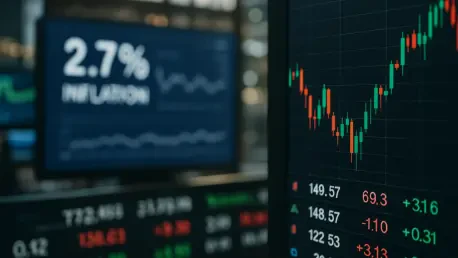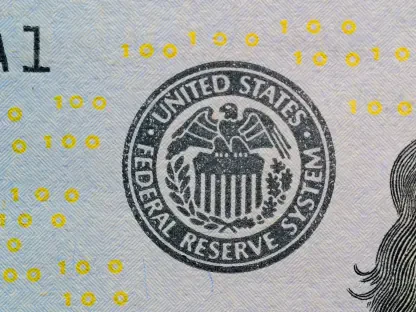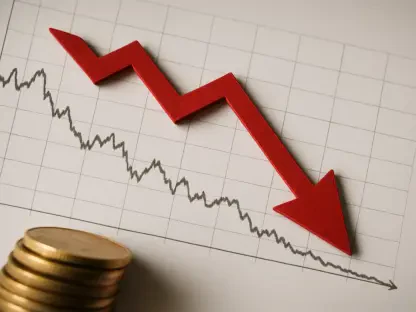The recent surge in Personal Consumption Expenditures (PCE) inflation to 2.7% year-over-year in August has sparked significant concern across economic circles, as reported from Washington, D.C., signaling a persistent challenge that defies the Federal Reserve’s 2% target. This incremental rise from 2.6% in July may seem modest at first glance, yet it underscores a deeper, stubborn inflationary pressure affecting everything from grocery bills to corporate earnings. Beyond just a statistic, this uptick reflects a complex web of factors—supply chain bottlenecks, escalating labor costs, and unwavering consumer spending—that are reshaping the financial landscape. Markets are jittery, businesses are recalibrating, and policymakers are on edge as they grapple with the implications. The effects ripple through commodity prices, corporate profitability, and even global economic trends, raising critical questions about resilience and adaptability. This article explores the multifaceted impact of this inflationary trend, delving into how it influences financial markets, alters commodity dynamics, challenges monetary policy, and creates both winners and losers in the corporate arena. By unpacking these layers, a clearer picture emerges of the strategies needed to navigate an economy under strain, offering insights for investors and business leaders alike.
Unpacking the Inflationary Surge
The climb to 2.7% PCE inflation in August represents more than just a fleeting economic blip; it’s a persistent hurdle that continues to test the economy’s stability, reflecting deeper challenges in achieving balance. Month-over-month, the PCE index rose by 0.3%, while the core services component, often referred to as “supercore” PCE, spiked to 3.6%, highlighting significant price increases in essential sectors beyond volatile food and energy categories. These figures point to an inflationary environment that refuses to relent, driven by a mix of external and internal pressures. Tariffs, which pass a substantial portion of their cost onto consumers, compound the issue, as do rising labor expenses that show no sign of abating. Meanwhile, consumer spending remains surprisingly robust, up 0.6% in August, fueling demand that keeps prices elevated. This combination of factors suggests that inflation is entrenched, posing a challenge to expectations of a quick return to the Fed’s target. For markets, this persistence translates into uncertainty, as investors weigh the likelihood of continued price pressures against hopes for stabilization. The broader implication is a potential shift in how economic growth is perceived, with inflation acting as both a barrier and a catalyst for strategic adjustments across sectors.
This inflationary persistence isn’t merely a domestic issue but a reflection of global economic undercurrents that amplify its impact, shaping the financial landscape in profound ways. Supply chain disruptions, lingering since earlier setbacks, continue to constrain the availability of goods, pushing costs higher across industries. Additionally, the strength of consumer demand, while a positive sign of economic vitality, paradoxically contributes to sustained price increases as businesses struggle to meet it without raising prices. Core PCE, holding steady at 2.9% when excluding food and energy, further illustrates that the root of inflation lies in structural challenges rather than temporary shocks. For corporate entities, this means grappling with input costs that erode margins unless offset by price hikes or efficiency gains. Financial markets, too, must recalibrate expectations, as the specter of prolonged inflation influences everything from bond yields to equity valuations. The significance of these trends cannot be overstated, as they set the stage for broader discussions on policy responses and market strategies, painting a picture of an economy at a critical juncture where adaptability becomes paramount.
The Federal Reserve’s Policy Tightrope
Navigating the current 2.7% PCE inflation rate presents a formidable dilemma for the Federal Reserve, caught between curbing price pressures and supporting a labor market showing signs of softening, while also weighing the broader economic implications. Following a recent 25 basis point rate cut, bringing the benchmark range to 4.00%-4.25%, Fed officials remain wary of further reductions. Strong economic indicators, such as a revised second-quarter GDP growth of 3.8% and a robust jobs report, diminish the urgency for aggressive monetary easing. Fed Chair Jerome Powell has signaled caution, emphasizing the risk that premature rate cuts could exacerbate inflation, potentially entrenching it further into economic expectations. Yet, holding rates too high for too long might stifle growth, particularly in sectors sensitive to borrowing costs. This delicate balance underscores the Fed’s challenge: maintaining credibility on price stability without tipping the economy into a downturn. For markets, the uncertainty around future rate decisions fuels volatility, as investors parse every statement and data point for clues on the Fed’s next move. The stakes are high, as policy missteps could have lasting repercussions across asset classes.
The broader implications of the Fed’s cautious stance extend beyond immediate market reactions to shape long-term economic expectations, especially as inflation remains stubbornly above the 2% target. The possibility of sustained higher rates—or even a reversal to tightening—looms large, particularly if price pressures show no signs of abating. This scenario poses challenges for businesses reliant on cheap credit, especially in capital-intensive industries like manufacturing and real estate. Meanwhile, robust economic data provides some buffer, suggesting the economy can withstand tighter conditions for now, but cracks in the labor market could shift this dynamic. Investors face a complex landscape where traditional safe havens like bonds may underperform if rates remain elevated, prompting a reevaluation of risk exposure. The Fed’s actions, or lack thereof, will likely dictate the pace of recovery or contraction in key sectors, making its policy path a focal point for anyone with a stake in financial markets. As this balancing act unfolds, the interplay between inflation control and economic growth remains a critical narrative to watch, influencing decisions from boardrooms to trading floors.
Commodity Markets Under Pressure
The link between 2.7% PCE inflation and commodity markets is undeniable, as rising inflation often correlates with higher prices for raw materials, creating both opportunities and risks for investors. Oil markets, for instance, face a mixed outlook: Brent crude could dip to $50-$59 per barrel by early next year due to increased global supply, yet geopolitical tensions in key producing regions might drive prices upward if supply tightens unexpectedly. Natural gas at Henry Hub is projected to rise, averaging $3.79/MMBtu this year, with further increases expected in the near future due to growing liquefied natural gas (LNG) exports. Precious metals like gold also stand out, with the potential to reach $3,000-$4,000 in the coming years as safe-haven demand surges amid economic uncertainty. These price movements reflect inflation’s dual role as a driver of commodity value and a source of volatility. For investors, commodities offer a hedge against inflation, but the unpredictability of short-term price swings demands careful navigation. The broader market impact is evident, as higher commodity costs feed into production expenses, influencing everything from energy bills to manufacturing budgets.
Beyond immediate price forecasts, the commodity space is shaped by structural shifts that amplify inflation’s effects over time, creating a complex landscape for investors and businesses alike. Industrial metals like copper benefit from sustained demand tied to infrastructure and technology, while oversupply in materials like nickel could temper price gains despite inflationary pressures. The volatility in energy markets, particularly oil and gas, stems from a delicate balance of geopolitical risks and production adjustments, making long-term planning a challenge for industries reliant on stable input costs. For financial markets, rising commodity prices often signal inflationary persistence, prompting shifts in investment strategies toward assets that can withstand price erosion. Meanwhile, businesses face the daunting task of managing higher raw material costs without alienating price-sensitive consumers. The interplay between inflation and commodities thus creates a feedback loop, where rising prices fuel inflation, which in turn pushes commodity values higher, setting the stage for a volatile yet potentially lucrative market environment that demands strategic foresight.
Energy Transition and Commodity Dynamics
The global shift toward sustainable energy adds a significant layer to the impact of 2.7% PCE inflation on commodity markets, particularly through heightened demand for materials essential to green technologies. Metals like copper and lithium, critical for electric vehicles and renewable energy infrastructure, are poised for a potential supercycle of elevated prices as the energy transition accelerates. This demand surge contrasts with declining investment in traditional fossil fuels, which could lead to supply shortages for oil and gas in the longer term, even as short-term oversupply pressures persist. Inflation exacerbates these trends by increasing production costs across the board, from mining operations to energy extraction, thereby pushing commodity prices higher. For markets, this creates a bifurcated outlook: green metals offer growth potential, while traditional energy commodities face uncertainty. Industries tied to the energy transition may thrive, but the broader economic impact hinges on how quickly supply can scale to meet burgeoning demand without further fueling inflationary pressures.
This structural shift in commodity demand due to the energy transition also introduces new risks and opportunities that inflation magnifies, creating a challenging landscape for various industries. While the push for electrification drives long-term value for specific metals, the lag in developing new mining capacity or recycling infrastructure could lead to price spikes, adding to cost pressures for manufacturers of batteries and renewable systems. Simultaneously, reduced capital expenditure in conventional oil fields, driven by both policy shifts and investor priorities, risks creating a supply-demand mismatch that could elevate energy prices unexpectedly. For corporate players, adapting to these dynamics means rethinking supply chains and investment priorities, especially under the weight of inflation-driven cost increases. Financial markets must also adjust, as the volatility in commodity prices tied to the energy transition influences broader indices and sector-specific investments. The intersection of inflation and sustainability goals thus shapes a complex landscape, where strategic positioning becomes crucial for capitalizing on emerging trends while mitigating the risks of price instability.
Corporate Landscape: Gains and Losses
The 2.7% PCE inflation rate carves a stark divide in the corporate world, creating clear winners and losers based on scale, efficiency, and sector exposure. Large oil and gas companies with low production costs and extensive economies of scale stand to benefit from rising energy prices, capitalizing on higher revenues without proportionate cost increases. Similarly, diversified mining giants positioned in high-demand metals like copper are well-placed to profit as prices climb, driven by both inflation and global infrastructure needs. These industry leaders can often pass on increased costs to consumers or absorb them through operational efficiencies, maintaining or even expanding profit margins. However, the picture darkens for smaller or less efficient players, such as high-cost refiners or niche metal processors, where rising input expenses outstrip their ability to adjust pricing. For markets, this disparity signals a flight to quality, as investors favor established firms with resilience over riskier, smaller entities. The broader implication is a potential widening of competitive gaps within industries, reshaping sector dynamics.
Downstream from commodity producers, the corporate impact of inflation extends to industries reliant on raw materials, where cost pressures are often unavoidable. Sectors like automotive manufacturing and food processing face escalating expenses for inputs such as steel, aluminum, and agricultural goods, which are directly influenced by commodity price surges tied to inflation. Passing these costs on to consumers risks dampening demand, especially as purchasing power erodes under broader price increases across the economy. Smaller firms in these sectors, lacking the pricing power or supply chain leverage of larger competitors, are particularly vulnerable to margin compression, potentially leading to reduced profitability or market share losses. Financial markets reflect this strain through cautious sentiment toward consumer-facing industries, where growth prospects dim if spending slows. The challenge for these companies lies in balancing cost management with customer retention, a task made harder by an inflationary environment that shows little sign of easing. This dynamic underscores the uneven impact across the corporate spectrum, highlighting the need for tailored strategies to weather the storm.
Global Forces Amplifying Inflation
The reach of 2.7% PCE inflation extends beyond domestic borders, intertwined with global economic forces that intensify its effects on markets and profits. Supply chain disruptions, a lingering issue for several years, continue to constrain the flow of goods, driving up costs for everything from raw materials to finished products. Geopolitical tensions further complicate the landscape, disrupting key commodity supplies like energy and agricultural goods, which in turn fuel price volatility. These international pressures create a feedback loop with inflation, as higher costs for imported goods and resources push domestic prices upward, challenging businesses to secure stable supply lines. For financial markets, this global uncertainty translates into heightened risk premiums, as investors grapple with unpredictable commodity price swings and potential trade disruptions. The interconnected nature of today’s economy means that no sector remains immune, with ripple effects touching industries and consumers alike, amplifying the urgency for adaptive measures in response to these external shocks.
Adding to the complexity, the global energy transition plays a pivotal role in shaping how inflation interacts with commodity markets on an international scale. The push for cleaner energy sources drives demand for specific resources, particularly metals integral to green technologies, creating sustained price pressures that inflation only magnifies. Meanwhile, geopolitical unrest in resource-rich regions threatens to constrain supply further, especially for oil and gas, where production is often concentrated in volatile areas. For multinational corporations, these factors necessitate a reevaluation of sourcing strategies and risk management, as exposure to global disruptions can erode profitability if not mitigated. Markets, too, must account for these variables, as currency fluctuations tied to a strong U.S. dollar—often a byproduct of domestic inflation and Fed policy—add another layer of complexity for international investments. Navigating this web of global influences requires a nuanced understanding of how local inflationary trends intersect with worldwide economic currents, shaping both immediate responses and long-term planning.
Strategies for Navigating Economic Uncertainty
With inflation projected to remain above the Federal Reserve’s 2% target into late next year, businesses must adopt proactive measures to safeguard profitability in this challenging environment. Rethinking pricing models to reflect rising costs without alienating customers is a critical first step, alongside efforts to streamline supply chains for greater resilience against disruptions. Investing in technology and process efficiencies can also help offset higher input expenses, particularly for industries facing tight margins due to commodity price surges. Financial management becomes equally important, as maintaining liquidity and reducing exposure to interest rate fluctuations can provide a buffer against tighter monetary conditions. For corporate leaders, the focus should be on agility—quickly adapting to shifting cost structures while preserving competitive positioning. Markets may reward such adaptability with sustained investor confidence, especially in sectors demonstrating robustness amid inflationary headwinds. The path forward demands a strategic mindset, prioritizing long-term stability over short-term gains.
Investors, meanwhile, face their own set of challenges and opportunities in light of persistent 2.7% PCE inflation, necessitating a recalibration of portfolios to weather potential volatility and safeguard their financial future. Diversifying into inflation-resilient assets, such as Treasury Inflation-Protected Securities (TIPS), real estate, and commodity-linked equities, offers a hedge against eroding purchasing power. Defensive sectors with strong dividend yields may also provide stability, contrasting with the risks of holding excessive cash or long-duration bonds in an environment of elevated rates. Exposure to emerging markets rich in critical resources tied to the energy transition could yield growth, though currency risks tied to a strong U.S. dollar warrant caution. Financial markets are likely to remain choppy as inflation and Fed policy evolve, making risk management paramount for preserving capital. Staying attuned to economic indicators and central bank signals will be essential for adjusting strategies in real time. As this inflationary chapter unfolds, a balanced approach to investment can help mitigate downside while capturing potential upside in a shifting landscape.
Reflecting on Inflation’s Broad Reach
Looking back, the acceleration of PCE inflation to 2.7% in August stood as a defining moment that tested the resilience of markets and corporate strategies alike, revealing the intricate interplay between persistent price pressures, monetary policy constraints, and global economic forces. It painted a picture of an economy grappling with multifaceted challenges. The strain on commodity prices, from oil to green metals, underscored how inflation reverberated through supply chains, while the Federal Reserve’s cautious stance highlighted the delicate balance between growth and stability. Corporate disparities emerged sharply, with efficient giants often thriving while smaller players struggled under cost burdens. Moving forward, the focus shifted to actionable steps—businesses needed to prioritize efficiency and supply chain diversification, while investors were encouraged to seek inflation-resistant assets and monitor policy shifts closely. Emerging markets with resource wealth offered potential, provided global risks were managed. As this period of economic tension was navigated, the emphasis rested on adaptability, with strategic foresight becoming the cornerstone for mitigating inflation’s impact and seizing opportunities in a volatile landscape.









